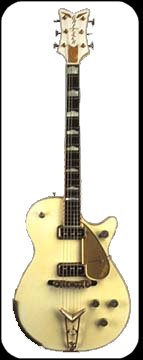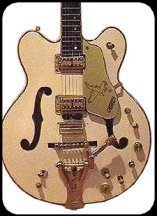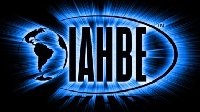|

1955 6134 WHITE PENGUIN
|
Gretsch 6136
White Falcon ®
If ever a guitar typified the
glorious excesses of the 1950s, the White Falcon
would be that guitar. To crib from Tom Wolfe,
it was a "Kandy-Kolored Tangerine-Flake Streamline
Baby."
And it was
"the most beautiful guitar in the world," to quote
the Gretsch literature of the day. A hellishly
expensive dreamboat even when new, White Falcons
continue to be highly treasured, high-dollar guitars.
But for all the things the 6136
White Falcon was, it was not necessarily intended
to be a production model at all. It was originally
a trade show guitar, a "dream machine" Gretsch
put together to show off a little. As the orders
came rushing in after its introduction at the
1954 music trade shows, the Falcon was rushed
into production.
The story really begins years
earlier with Gretsch master salesman and player
Jimmy Webster. During the World War II Webster
was playing an all-white Harmony. Pictures of
him playing the guitar turned up in an armed forces
newsletter, interestingly titled The White
Falcon.
After the war, Webster would wander
the Gretsch factory, looking for ideas. The Falcon's
outrageous blend of looks and features came from
several places in the factory, as well as from
Webster's penchant for gizmos.
|
From the drum side, Webster picked up gold sparkle
drum material. From the banjo side, he saw the rhinestones and
other ornamentation that bejeweled the high-end banjos.
He threw it all in the air, and a White Falcon
came back down to him.
From its debut in '54, the Falcon featured gleaming
white paint and gold sparkle trim, 24-karat gold-plated metal
parts, ebony and real mother of pearl, all working together
to dazzle players and dreamers alike. The guitar had three-layer
white, gold and black binding, bird-themed engravings on the
neck markers, a special winged headstock and "Cadillac G" tailpiece,
so named becauce the "V" at the end was reminiscent of a Cadillac
logo, back when Cadillac was "The Standard of the World," and
the first GM division with modern V-8 engine, too.
All the Falcon's hardware was top-shelf, right
down to the Grover Imperial tuners. It was also, except for
the occasional Country Club, the only spruce-topped Gretsch.
It was a big bird, too, at 17 inches wide and almost three inches
deep.
The next year the 6134 White Penguin was introduced.
Essentially a Duo-Jet trying to fly high, the Penguin sported
most of the White Falcon features on a Jet body. Few were sold,
and even those few are rarely seen today. While a Holy Grail
for collectors, they are essentially a footnote to the White
Falcon story. The penguin on the pickguard was memorable, though.
The Falcon remained essentially unchanged until
1958, when a new headstock style was introduced, with the Gretsch
script running horizontally instead of vertically. Many of these
also have a square metal nameplate on the headstock. Half-moon
neo-classic markers replaced the block markers in '58.
For 1959, the Falcon gained a zero fret, along
with a space control bridge replacing the Melita previously
used. New wiring also debuted with FilterTron pickups and a
three-position tone selector switch.
The 6137 Project-O-Sonic White Falcon was also
introduced in 1958 or '59.
For 1962 big changes came to the Falcons, along
with most of the rest of the Gretsch line. Bodies changed to
a double-cutaway, thinner design and a double mute system and
standby switch were the new features. The price was up to $800.
If you wanted stereo, take a cool grand to the store.
Gretsch couldn't seem to leave the bird alone,
so in 1964 the Falcon was introduced to the "T-zone tempered
treble" system, a slight angle on the highest frets said to
improve treble response, and a new, telescoping arm vibrato.
| Gadgets contined
to be thrown at the Falcon. In 1966 it gained the "Amazing
Gretsch Floating Sound Unit," a tuning fork which was supposed
to dangle down in the body of the guitar to increase resonance
and sustain. Most were promptly removed, as they made the
Guitar of Kings a royal pain to set up. By now there were
so many knobs and switches stuck on the White Falcon it
took an electrical engineer, not a guitar player, to actually
use one.
Much like the Cadillacs they took styling
cues from and that other icon of the 50s, Elvis, the Falcons
entered the '70s as a bloated parody of the cool they
had once embodied. But during the '70s, Baldwin began
taking some of the sillier "features" off Falcons. Whether
this was a good idea that actually came from the Baldwin
offices or just another example of cost-cutting is open
to debate. Single cutaway Falcons were also re-introduced
in 1974, bringing back even more of the classic, uncluttered
style.
Currently, the revitalized Gretsch company
offers several reissue versions of the White Falcon,
as well as variants such as the Black Falcon and
White Falcon Rancher.
|

|








